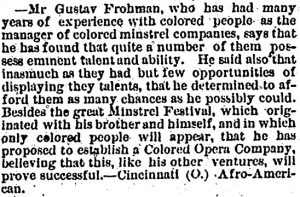Minstrel shows are most commonly known as a performance in which black culture is represented with an extreme amount of negative stereotyping. Blackface, the practice of having a white man imitate the skin tone of an African American through the use of burned cork makeup, is presented as one of the greatest demonstrations of bad taste and racist portrayals, and often as a defining feature of these performances. However, it is easy to forget that the reality was far more nuanced.
As this snippet from a prominent newspaper of the time shows, it was quite often that African Americans performed in minstrel shows. Gustav Frohman was a prominent theater manager, specializing in minstrel shows, and operated one of the most successful black performance troupes of the 19th century. In his remarks to the newspaper, it can be seen that he identifies that few opportunities for African Americans exist, and that his sentiment is to give as many opportunities out as possible.
Of course, it is difficult to know if this is what he truly believes or if he is doing a variation of virtue signaling by saying that providing opportunities is important despite what he truly believes. However, the presence of such a statement in a significant newspaper indicates that such things were important to at least a not insignificant amount of people. Otherwise, why would it be in such a large publication?
Statements like these perhaps contain the notion that these shows are a good thing, as they provide opportunities that would not otherwise exist and allow for the chance to demonstrate skills. Either way, in looking back on a practice that is considered to be very distasteful today, it is valuable to consider such statements, especially those in public view, and imagine what the public perception of the event must have been, unbiased by our modern assertions.
Citations:
“Mr. Gustav Frohman.” New York Globe (New York, New York), December 22, 1883: 4. Readex: African American Newspapers. https://infoweb.newsbank.com.

